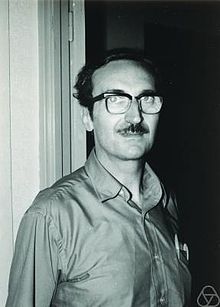Eugenio Calabi
Eugenio Calabi (born May 11, 1923 in Milan ) is an Italian mathematician specializing in differential geometry .
Calabi studied at the Massachusetts Institute of Technology with a bachelor's degree in 1946 and at the University of Illinois with a master's degree in 1947. In 1950 he received his Ph.D. from Princeton University , where he had been an instructor since 1947. Calabi's supervising professor was Salomon Bochner . In 1951 he was Assistant Professor at Louisiana State University and in 1955 Assistant Professor and then Professor at the University of Minnesota .
1964 Calabi became professor of mathematics at the University of Pennsylvania , since 1969 on the "Thomas A. Scott chair". From 1973 to 1976 he headed the mathematics faculty. In 1982 he was elected to the National Academy of Sciences . He received the American Mathematical Society's Leroy P. Steele Prize in 1991 for his work in the field of differential geometry. In 1994 he retired.
In 1958/59 he was at the Institute for Advanced Study . In 1962/63 he was a Guggenheim Fellow. He is a fellow of the American Mathematical Society .
His work on the Kähler metric led to the development of the Calabi-Yau manifold , which is one of his most important work. In 1954 he hypothesized that Kähler manifolds with vanishing first Chern class have Ricci-flat Kähler metrics (which also defines Calabi-Yau manifolds), proven by Shing-Tung Yau in 1977.
In 1962 he gave a lecture at the International Congress of Mathematicians in Stockholm ( Operational calculus in several variables ).
Calabi is a US citizen. He has been married since 1952 and has one child.
Individual evidence
- ↑ Life data according to American Men and Women of Science , Thomson Gale 2004
- ↑ Calabi The space of Kähler metrics , Proc. Boarding school Congress Math. Amsterdam, 1954, pp. 206-207, On Kähler manifolds with vanishing canonical class , in Algebraic geometry and topology. A symposium in honor of Solomon Lefschetz , Princeton University Press, 1957, pp. 78-89
- ↑ that means vanishing Ricci curvature
Web link
| personal data | |
|---|---|
| SURNAME | Calabi, Eugenio |
| BRIEF DESCRIPTION | Italian mathematician |
| DATE OF BIRTH | May 11, 1923 |
| PLACE OF BIRTH | Milan |
